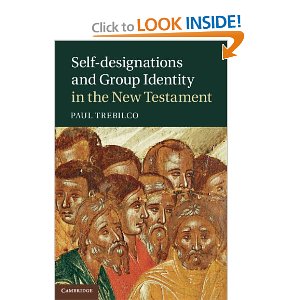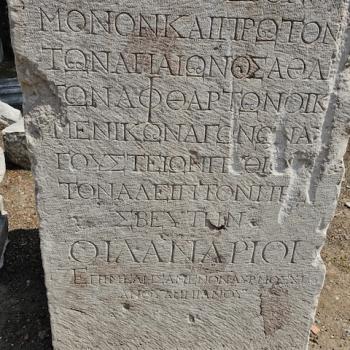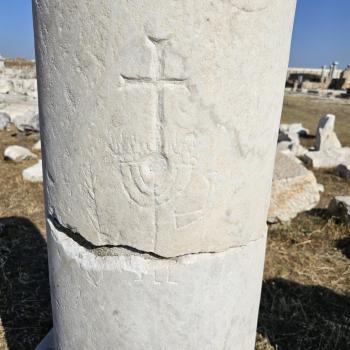In some ways the most interesting and enlightening chapter in Paul Trebilco’s recent monograph is the discussion about the hagioi— the holy ones or saints. The plural term hagioi is used some 60 times in the NT, predominantly in Paul where we have 30 examples, not counting the seven more in Ephesians and one in the Pastorals. What is most interesting about the use of this term of early Christians is that in the OT, whether the Hebrew or the LXX, the term is used in the first instance of angels (cf. Deut. 33.2-3; Job 5.1;15.15;Ps. 16.3; 89., but also of Jewish believers. The root meaning of ‘qadosh’ is however of something that belongs to the deity, in this case Yahweh, and so is set apart from every day usage or purposes. God’s people are themselves viewed that way, as rather like the human equivalent of sacred vessels. Especially interesting is the use of holy ones in Daniel 7-8 where it can be debated at what points the reference is to angels, and what points to humans. But as Trebilco says, the relationship between angels and God’s people is particularly close in apocalyptic literature— there are angels specifically assigned to protect God’s people as a nation and as individuals, and this is probably how we should read the references to the spirits of the churches in Revelation 2-3 as well. 1 Enoch 100.5 is epsecially striking— God will set angels as guardians over God’s ‘holy ones’ (i.e. people). In 1 Enoch 47 we hear about the holy ones who dwell in heaven (i.e. angels) and those who dwell on earth (i.e. God’s people). This close association helps us to understand texts like Mark. 16.5-6 where the ‘young men’ are in fact guardian angels. It also helps us to understand comments like Jesus’ rebuke to the Sadducees in Mark 12 where he says in the life to come ‘we will be like the angels, neither marrying nor giving in marriage’. In the eschatological time, believers mingle with angels with some regularity (see Heb. 12 for example).
It is important to note that when the NT writers, particularly Paul uses the term hoi hagioi he is referring to all Christians in the audience in question, not a particular group of them that could be called especially ‘holy’ in the moral sense. Notice 1 Cor. 1.2 for example where even the Corinthians are said to be holy ones sanctified in Christ. Trebilco notes how this language mostly occurs at the beginning and end of letters concludes “The function of this language is to emphasize unity and oneness both of the whole group of addressees themselves, but also with the wider Christian movement.” (p. 130).
The phenomena of ‘reappropriation’ or ‘reapplication’ of terms formerly used of Israel, but now used of the followers of Christ is common and the use of ‘holy ones’ is one good example of this. Those who have been set apart by God are called to live ‘morally holy lives’ but whether they do or not, the term is still applied to the group since they are still ‘set apart ones’ even when they misbehave. Paul is in essence urging the immoral Corinthians to ‘become what you have already been designated to be’. What is most remarkable is that Paul is prepared to call Gentile believers ‘saints’, who were not proselytes to Judaism, were not circumcised and so not set apart in the OT way, were not priests, and had not kept the Mosaic Law. (See Trebilco p. 136). Indeed he is even prepared to call the largely Gentile congregation in Corinth ‘the Temple of God’ (1 Cor. 3.16-17). This can only be called a radical reapplication of Jewish language in a different way.
Trebilco goes on to show on the basis of both Paul (Gal. 2; Rom. 15) and Acts that the term ‘saints’ was applied in the pre-Pauline or earliest period to Jewish Christians who were part of the Jerusalem church. He thinks the Christian use of the term originated there (p. 143), but Paul later broadens the use of the term, in a dramatic way (a change possibly signaled by Acts 15 where Gentile Christ followers are addressed as brothers etc.).
We find some 14 uses of hagioi of Christians in Revelation but hagios is also a term used of angels (14.10) and Christ and God (3.7 and 4.8). Here we see the use of such language in an eschatological context where the echoes of Dan. 7 for instance are clear.
In conclusion Trebilco notes that ‘hagioi’ is never used as a term of direct address, but always as a self-designation. In Ephesians and Jude it is used of angels as in the OT, but predominantly of believers in the NT. Indeed, the very use of the term of present Christian communities bespeaks their eschatological mindset, because in early Jewish literature like 1 Enoch it is used of the future people of God. It is important to note, in light of later use of the saint language to describe particular and particularly holy men or women, that this is not how the term is used in the NT— where it is used of all believers, whole communities such as the ones in Jerusalem or Corinth. Trebilco finally stresses that this is inward facing language. It is not for example how Christians would identify themselves to outsiders as it would have made little sense, or sounded pretentious.













